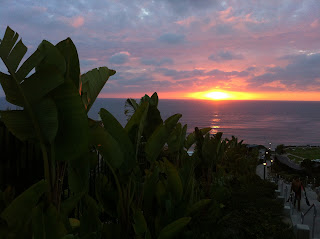Earlier this evening I was reading "Bishop Blougram's Apology" by Robert Browning for my poetry class. It's a lengthy poem & a dramatic monologue (where the narrator is speaking to someone else as if in a monologue or soliloquy within a play, but we only are given his voice and have to construct the surrounding story from what is revealed). It's also in part a work of apologetics (that is, a defense of the Faith: hence, the title).
At one point, the narrator, a bishop giving an interview to an unbelieving journalist, asks him to imagine that they are both unbelievers and to reason from that premise:
And now what are we? unbelievers both,
Calm and complete, determinedly fixed
To-day, to-morrow, forever, pray?
You'll guarantee me that? Not so, I think.
. . . how can we guard our unbelief,
Make it bear fruit to us?—the problem here.
Just when we are safest, there's a sunset-touch,
A fancy from a flower-bell, someone's death, . . .
And that's enough for fifty hopes and fears
As old and new at once as Nature's self,
To rap and knock and enter in our soul, . . .
The grand Perhaps! (lines 174-91)
In other words, writes Browning, humans can think they are safe from challenges to their unbelief, but all it takes is something as seemingly simple as a sunset to awaken the question within our soul: what if there is a God?
One of the joys of living only a few miles from the coast is that I can frequently grab the opportunity to view a sunset on the Pacific Ocean. A few weeks ago, watching one of these sunsets at my new favorite park, I remarked to a friendly passer-by that only God could have painted such a sunset, as it was beyond a human's ability to even conceive of something so varied and beautiful. He agreed, and it opened the door for planting at least this first seed of the Gospel: that God is our Creator.
George Herbert also reminds us that the sun should point us toward our Creator in his poem "Mattens," which is actually about the sunrise. Since I don't ever see the sunrise, I'll apply his words to the setting sun instead:
Teach me Thy love to know;
That this new light, which now I see
May both the work and workman show;
Then by a sun-beam I will climb to Thee. (stanza 5)
This final stanza of "Mattens" comes on the heels of a lament that man "did not heaven and earth create, / Yet studies them, not Him by Whom they be" (lines 15-16). Herbert's hope is that creation will reveal to us both itself ("work") and its Creator ("workman").
My picture above captures the sunbeams on the water at Dana Point, CA. In a play on words, Herbert alludes to Christ's cross (sun/Son + beam [of wood]) as the way he will "climb" to the Father. May our thoughts climb to Heaven when we view a sunrise or sunset, and may unbelievers that we know experience this "sunset-touch," as Browning calls it, and come to faith through the Son's beam.

No comments:
Post a Comment